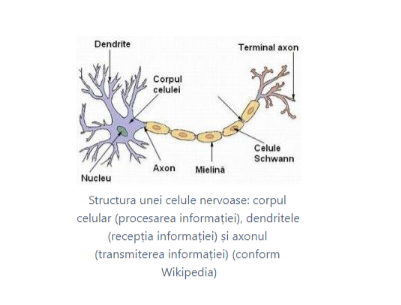Neurons and the nervous system
The basic building blocks of the brain are nerve cells (neurons). All nerve cells form the nervous system. The brain is made up of about 100 billion nerve cells, but more important to brain function is the network between these nerve cells.
Content
The basic building blocks of the brain are nerve cells (neurons). All nerve cells form the nervous system. The brain consists of approximately 100 billion nerve cells. However, the most important thing for the functioning of the brain is the network between nerve cells. Neurons are specialized in receiving signals, processing them and sending an impulse when a certain signal threshold is reached.
Structure
A nerve cell consists of three basic elements:
the cell body with one nucleus and two types of projections,
dendrites
the axon.
The role of dendrites is to receive information, and information is transmitted through the axon.

Structure of a nerve cell: cell body (information processing), dendrites (information reception) and axon (information transmission) (according to Wikipedia)
The functions of a nerve cell
The way a nerve cell works is relatively simple, but its function in a network is extremely complex due to the large number of connections. Nerve cells communicate with each other through electrical signals. When the sum of input signals from other nerve cells exceeds a certain threshold in a nerve cell, an output signal (action potential) is sent down the axon. If the input pulse is below this threshold, there is no reaction. At the end of the axon, the action potential then reaches the synapse. Through these synapses, the axon is connected to other nerve cells (or muscle cells) and transmits the impulse. On average, each nerve cell has about 1,000 synapses, but there can be as many as 100,000.
Synaptic transmission is largely chemical in nature, meaning it can be modulated (for example by medicines or drugs). The impulse can be transmitted along the synaptic cleft by the molecules of a transmitting substance (neurotransmitters such as dopamine, adrenaline). The stronger the action potential, the more neurotransmitter is released from the synapse. Some neurotransmitters increase the electrical impulse of the connected cell, but others can also inhibit it. In the receiving cell, the chemical signal is then converted back into an electrical signal by means of certain receptors. If enough neurotransmitters are received and a certain threshold is exceeded again, a new action potential is triggered in the receiving cell and the impulse is passed on.
What does this mean for my teaching practice?
During learning, new connections are made between nerve cells. The more complex these connections are, the more efficient the brain is.
Reflection question
Why can drugs and medicine affect us so much, not only physiologically, but also psychologically?
Quiz
1) Which is more important for the function of the brain?
A) Number of nerve cells
B) Connections between nerve cells
2) An action potential can activate a connected cell via neurotransmitters
A) only activate
B) only inhibit
C) activate or inhibit